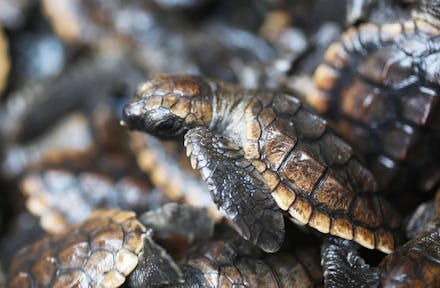Florida Power Plant Has Sucked In Over 4,100 Sea Turtles in the Past Decade

Over the past decade, over 4,100 sea turtles — averaging to more than a turtle a day — have been sucked into the St. Lucie Nuclear Power Plant on Hutchinson Island in Florida, resulting in injuries and even deaths, TCPalm reported. Since the plant opened in 1976, about 16,000 turtles, mainly the threatened loggerhead and endangered green, have been affected.
Xander, a subadult loggerhead, is just one of these many turtles. In August, he was found tangled up in fishing line and wounded in the canal. After being rescued, Xander was given antibiotics and underwent orthopedic surgery. After treatment, he was released back into the wild on March 31, according to the Loggerhead Marinelife Center.
The federal government is finally stepping in to build pipe grates on the three pipes, each a quarter-mile long, that run through the ocean, which will take two years to build and test. This is the first step taken in addressing this issue, but the crosshatched mesh grate will only protect about 27% of the turtles that ever enter the pipes. Any smaller mesh would also stop water flow, the Florida Power & Light Company said, according to TCPalm.
Read more: A Wounded Turtle Got a 3-D Printed Upgrade and a New Lease on Life
"St. Lucie power plant is very unique with the number of turtles it captures, just because of its location," biologist Cody Mott said, according to TCPalm. "Not many other facilities have this many turtles or have to deal with these issues."
Biologists guess that turtles think the pipes are a part of the nearby reef, which they use as protection. Most of the turtles that take the five-minute long journey through the pipes suffer small injuries, such as cuts and scrapes. Data on how many are killed is lacking but in 2001, 0.8% of the 8,832 turtles who entered the pipes died from the journey, according to TCPalm.
Since 1978, loggerhead turtles have been on the threatened species list due to their declining populations as a result of a lack of places to nest, according to National Geographic. Overharvesting, fishing and hunting have also led to green turtles being classified as endangered.
While approving the grate, the National Marine Fisheries Service cap for turtles sucked into the pipes have been upped to 1,143 from 1,000. The quotas of turtles allowed to be severely hurt or killed also increased, with three loggerheads allowed for both categories each year.
The gate's approval took nine years to complete, only really picking up steam after a second scuba diver was sucked into the pipes, according to the Palm Beach Post. "I kind of felt like I got sucked over a waterfall and just instantly complete darkness. I was getting tumbled around and around," the diver, Christopher Le Cun, said about his experience, according to Palm Beach Post.
As scary as these pipes probably sound, some, such as the plant's Inwater Research Group, argue that they actually help with turtle conservation by sending the turtles into a secure area where they can be studied.